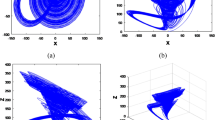Abstract
Chaos has been applied extensively in secure communication over the last decade, but most of the chaotic security protocols defined, are cryptographically weak or slow to compute. Also, study of chaotic phenomena as application in security area is not discussed in detail. In this paper, we have intensely studied chaos, their influence in secure communications and proposed a steganography technique in spatial domain for digital images based upon chaotic maps. By applying chaos effectively in secure communication, the strength of the overall anticipated algorithm has been increased to a significant level. In addition, few security statistical analyses such as correlation, entropy, energy, contrast, homogeneity, peak signal to noise ratio, and mean square error have also been carried out and shown that it can survive against various differential attacks such as the known message attack, known cover attack, known stego attack, and stego only attack.








Similar content being viewed by others
References
Johnson, N.F., Jajodia, S.: Exploring steganography: seeing the unseen. Computer 31(2), 26–34 (1998)
Judge, J.C.: Steganography: past, present, future. SANS Institute publication. http://www.sans.org/reading-room/whitepapers/stenganography/552.php (2001)
Provos, N., Honeyman, P.: Hide and seek: an introduction to steganography. IEEE Secur. Priv. 1(3), 32–44 (2003)
Sadkhan, S.B.: Cryptography: current status and future trends. In: Proceedings of IEEE, International Conference on Information & Communication Technologies: From Theory to Applications, Damascus, Syria, pp. 417–418 (2004)
Moulin, P., Koetter, R.: Data-hiding codes. Proc. IEEE 93(12), 2083–2126 (2005)
Yang, T., Wu, C.W., Chua, L.O.: Cryptography based on chaotic systems. IEEE Trans. Circuits Syst. I 44(5), 469–472 (1997)
Verhulst, P.F.: Recherches mathématiques sur la loi d’accroissement de la population. Nouv. Mem. Acad. R. Sci. B.-Lett. Brux. 18, 1–41 (1845)
May, R.M.: Biological populations with nonoverlapping generations, stable points, stable cycles, and chaos. Science 186, 645–647 (1974)
May, R.M.: Biological populations obeying difference equations, stable points, stable cycles, and chaos. J. Theor. Biol. 51(2), 511–524 (1975)
May, R.M.: Simple mathematical models with very complicated dynamics. Nature 261, 459–467 (1976)
Gao, H., Zhang, Y., Liang, S., Li, D.: A new chaotic algorithm for image encryption. Chaos Solitons Fractals 29(2), 393–399 (2006)
Sheng, L.-Y., Sun, K.-H., Li, C.-B.: Study of a discrete chaotic system based on tangent-delay for elliptic reflecting cavity and its properties. Acta Phys. Sin. 53(9), 2871–2876 (2004)
Sheng, L.-Y., Cao, L.-l., Sun, K.-h., Wen, J.: Pseudo-random number generator based on TD-ERCS chaos and its statistic characteristics analysis. Acta Phys. Sin. 54(9), 4031–4037 (2005)
Author information
Authors and Affiliations
Corresponding author
Rights and permissions
About this article
Cite this article
Anees, A., Siddiqui, A.M., Ahmed, J. et al. A technique for digital steganography using chaotic maps. Nonlinear Dyn 75, 807–816 (2014). https://doi.org/10.1007/s11071-013-1105-3
Received:
Accepted:
Published:
Issue Date:
DOI: https://doi.org/10.1007/s11071-013-1105-3




